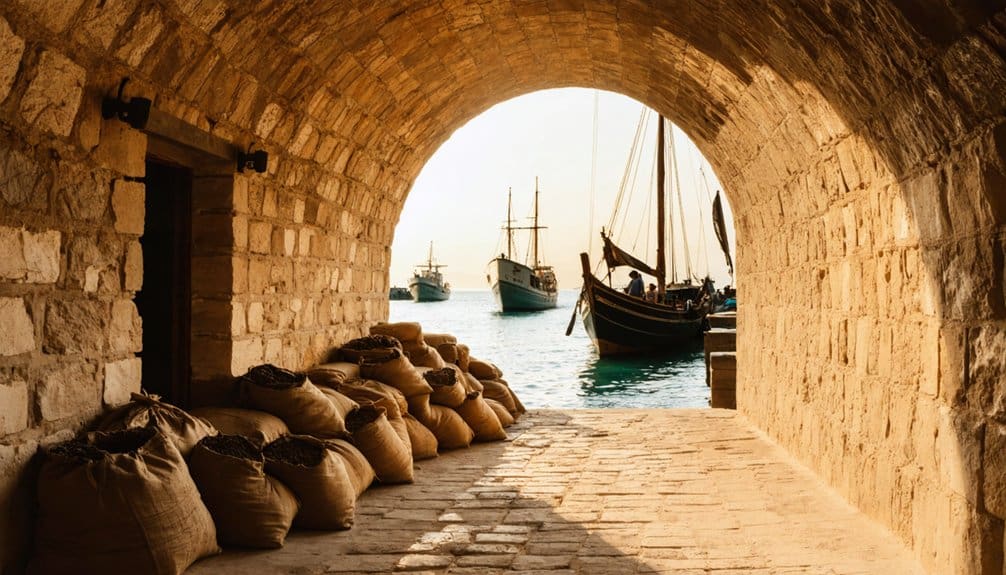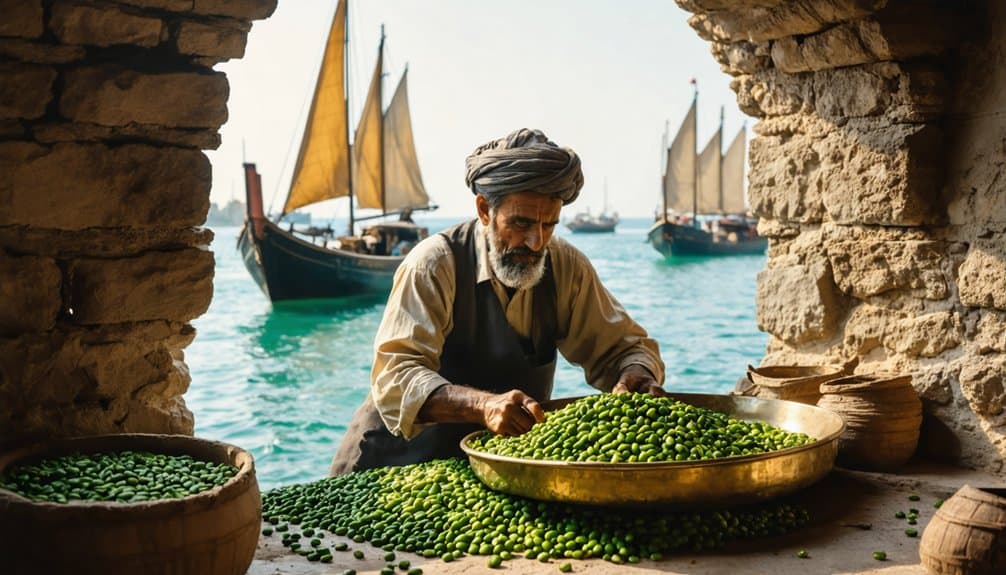You’ll uncover Yemen’s port of Mocha shaped coffee’s global expedition from the 14th century onward, transforming from a Sufi monks’ spiritual aid into the world’s premier coffee-trading hub.
The region’s volcanic soils and high elevations produce beans with distinctive chocolate undertones and winey acidity, while ancient cultivation methods perfected by Yemeni farmers guarantee exceptional quality.
This historic legacy lives on as modern producers revive traditional techniques, offering a taste of coffee’s earliest origins.
Key Takeaways
- Mocha port dominated global coffee trade in the 14th-18th centuries, establishing Yemen’s reputation as the birthplace of coffee commerce.
- Traditional Yemeni coffee beans feature distinctive chocolate undertones and winey acidity, influenced by high-altitude volcanic soils.
- Sufi monks pioneered coffee cultivation and brewing techniques, spreading coffee culture from Yemen to Mecca and beyond.
- Yemen’s coffee heritage reflects five centuries of tradition, with ancient farming methods still influencing modern cultivation practices.
- The port city’s legacy lives on through specialty coffee movements that preserve traditional growing methods while supporting local communities.
The Rise of Yemen’s Legendary Coffee Port

As Yemen’s Red Sea coast flourished in the 14th century, the port city of Mocha emerged under the spiritual guidance of Shaykh Shādhilī, quickly establishing itself as Arabia’s premier coffee-exporting hub.
You’ll find that Mocha’s strategic coastal location made it irresistible to European powers, who established trading posts to access its prized coffee beans.
Under Ottoman suzerainty, you’d have witnessed Mocha’s golden period in the 17th and early 18th centuries.
The port’s influence extended beyond coffee, as Indian and Egyptian merchants arrived to exchange metal goods for coffee and myrrh, while the port of Zeila paid tribute to Mocha’s rulers.
Initially, coffee was consumed as a religious aide for prayers by Sufi monks before spreading throughout the region.
From Sufi Prayers to Global Trade Routes
While Ethiopia gave birth to coffee plants, Yemen’s spiritual awakening through coffee began with Sufi monks in the 15th century, who uncovered its power to sustain their midnight prayers and deepen their spiritual practices.
As coffee spread to Mecca, you’ll find its story intertwined with scholarly debates over its legitimacy in Islamic practice.
Once accepted, Yemen’s farmers mastered cultivation in the highlands, developing techniques perfectly suited to their unique climate.
Through the bustling port of Mocha, these precious beans traveled maritime routes to Europe, where they’d spark a cultural revolution.
The Ottoman Empire’s expansion carried Yemen’s coffee legacy across continents, establishing coffeehouses as centers of intellectual exchange.
These qahveh khaneh became vital spaces for sharing stories and engaging in intellectual discussions.
The Distinctive Flavor Profile of Mocha Beans

Yemeni Mocha beans deliver a distinctly complex flavor profile that emerges from their distinctive growing conditions.
You’ll uncover a rich tapestry of flavors, from chocolate undertones to winey acidity, shaped by Yemen’s volcanic soils and traditional dry processing methods.
Growing at elevations up to 7,900 feet high, these cherished beans develop their signature characteristics in Yemen’s challenging terrain.
| Region | Body | Key Notes |
|---|---|---|
| Al-Mattari | Full | Spicy, honey |
| Al-Dhamari | Medium | Fruity, smooth |
| Al-Hirazi | Bold | Tangy fruit |
| Al-Ismaili | Light | Bright berries |
When you’re brewing these beans, you’ll find they respond best to darker roasts, which transform their winey fruit tones into bold chocolate notes.
Whether you choose French Press for full-bodied results or Pour Over for cleaner notes, you’ll experience the authentic taste that’s made Mocha beans legendary.
Yemen’s Coffee Heritage and Cultural Impact
Deep within the Arabian Peninsula, Yemen’s coffee heritage stretches back more than five centuries, marking the birthplace of coffee cultivation and trade.
You’ll find that Sufi monks initially processed and brewed coffee here, developing techniques that would shape global coffee culture.
Through Yemen’s port of Mocha, these precious beans reached every corner of the world, making Yemen the exclusive coffee supplier until the 1700s.
In Yemeni society, you’re participating in centuries-old traditions when you share coffee.
It’s a symbol of hospitality and community bonding that transcends generations, uniting people across different backgrounds while preserving the country’s rich cultural identity.
Many modern coffee varieties trace their genetic roots to Yemen, with 98 percent origin demonstrating the country’s profound influence on global coffee cultivation.
Modern Revival of Ancient Mocha Traditions

As global interest in specialty coffee surges, traditional Yemeni Mocha cultivation is experiencing a remarkable renaissance through collaborative efforts between local farmers and international partners.
You’ll find farmers in mountainous Haraz regions reviving centuries-old techniques while embracing sustainable practices and fair trade principles.
The region’s dry-processing method continues to distinguish Yemeni coffee with its distinctive sweetness and complexity.
- Direct partnerships with organizations like Mocha Hunters guarantee fair compensation and quality control
- Infrastructure development and education initiatives strengthen local farming communities
- Young entrepreneurs with Yemeni roots are leading efforts to modernize while preserving cultural authenticity
This revival represents more than just coffee production—it’s a bridge between Yemen’s rich heritage and contemporary global coffee culture, where traditional methods meet modern sustainability standards.
FAQs
Why Did European Traders Initially Avoid Buying Coffee Directly From Yemen?
You couldn’t trade directly with Yemen due to their restrictive policies, so you’d source coffee through Egypt and Turkey, where established trade networks and middlemen handled the transactions.
How Did Yemen’s Traditional Coffee-Drying Methods Differ From Other Regions?
You’ll find Yemen’s coffee-drying method stands out because farmers dry beans with their fruit husks intact, while other regions remove the fruit initially, making Yemen’s approach unique and time-intensive.
What Role Did Women Play in Yemen’s Historic Coffee Production?
You’ll find women were the gentle hands behind Yemen’s coffee story, tending crops, hand-picking cherries, and drying beans on rooftops. They’ve mastered cultivation, cupping, and roasting through generations of expertise.
How Did Yemen Protect Its Coffee Monopoly Before the 1600S?
You’ll find Yemen protected its coffee monopoly through strict control of live plants and seeds, limiting plantation access, keeping cultivation methods secret, and centralizing all exports through Mocha port’s strategic location.
Which Specific Diseases Affected Yemen’s Historic Coffee Crops?
You’d expect detailed records of historic coffee diseases in Yemen, but they don’t exist. While water stress and humid port conditions affected crops, specific pathogens from that period weren’t documented.
The Bottom Line
When you drink Yemen Mocha coffee today, you’re tasting centuries of tradition that began in the ancient port of Al-Mokha.
Consider how in 2018, Yemeni-American Mokhtar Alkhanshali successfully revived direct trade with Yemen’s coffee farmers, paying premium prices for their legendary beans.
This renaissance has helped preserve both the distinct chocolate-wine notes of genuine Mocha coffee and the cultural heritage of Yemen’s historic coffee trade.
